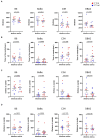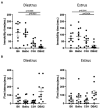Minimal influence of estrous cycle on studies of female mouse behaviors
- PMID: 37470056
- PMCID: PMC10352621
- DOI: 10.3389/fnmol.2023.1146109
Minimal influence of estrous cycle on studies of female mouse behaviors
Abstract
Introduction: Sex bias has been an issue in many biomedical fields, especially in neuroscience. In rodent research, many scientists only focused on male animals due to the belief that female estrous cycle gives rise to unacceptable, high levels of variance in the experiments. However, even though female sexual behaviors are well known to be regulated by estrous cycle, which effects on other non-sexual behaviors were not always consistent in previous reports. Recent reviews analyzing published literature even suggested that there is no evidence for larger variation in female than male in several phenotypes.
Methods: To further investigate the impact of estrous cycle on the variability of female behaviors, we conducted multiple behavioral assays, including the open field test, forced swimming test, and resident-intruder assay to assess anxiety-, depression-like behaviors, as well as social interaction respectively. We compared females in the estrus and diestrus stages across four different mouse strains: C57BL/6, BALB/c, C3H, and DBA/2.
Results: Our results found no significant difference in most behavioral parameters between females in these two stages. On the other hand, the differences in behaviors among certain strains are relatively consistent in both stages, suggesting a very minimal effect of estrous cycle for detecting the behavioral difference. Last, we compared the behavioral variation between male and female and found very similar variations in most behaviors between the two sexes.
Discussion: While our study successfully identified behavioral differences among strains and between the sexes, we did not find solid evidence to support the notion that female behaviors are influenced by the estrous cycle. Additionally, we observed similar levels of behavioral variability between males and females. Female mice, therefore, have no reason to be excluded in future behavioral research.
Keywords: behavioral variation; estrous cycle; female mouse behaviors; sex bias; sex differences.
Copyright © 2023 Zeng, Tsai, Lee, Ma and Kuo.
Conflict of interest statement
The authors declare that the research was conducted in the absence of any commercial or financial relationships that could be construed as a potential conflict of interest.
Figures











References
LinkOut - more resources
Full Text Sources

